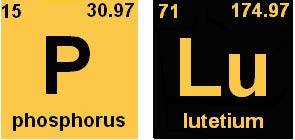2018 Chemistry Capstone Symposium
PLU Chemistry Department 
April 30th to May 4th, 2018 Chemistry Department Senior Capstone
The schedule of talks and abstracts is given below.
[ Monday | Tuesday | Wednesday | Thursday | Friday ]
Keynote Speaker: Eric Brauser, Ph.D. (and PLU ’10), TerraPower, LLC
All talks will be held in Morken Center for Learning and Technology (MCLT), Room 103
Monday, April 30th , 2018 (Morken Center for Learning and Technology, Room 103)
1:40 pm - Welcome
1:45 pm - Implications of Tau Protein in Alzheimer's Disease: A Contemporary Literature and Research Review
Shawn Brookins, Senior Capstone Seminar
Alzheimer’s Disease, the most common form of progressive dementia, has transitioned among the forefront of healthcare research, lending to novel biochemistry research avenues. In particular, research has attempted to implicate malconformations of tau protein in the development of this pathology. This review summarizes the competing hypotheses that attribute truncated and hyperphosphorylated tau variants to the disease. This review intends to assert the validity of both hypotheses from recent induced mutation, immunoblotting, and multi-label confocal immunofluorescence studies, followed by a projection for future research.

2:20 pm - Conversion of Ureas to Hydroxyguanidines for Conjugation to Drug-releasing Polymers by Nitroso-Diels-Alder Reactions
North Foulon, Senior Capstone Seminar
Hydroxyguanidines are a valuable class of molecules in the field of long-acting medications because they can be made to include the structural features of various urea-based drugs and are readily attached to drug-polymer conjugate systems as Diels-Alder adducts. Here, a method of converting mono-, di-, and tri-substituted ureas to their corresponding hydroxyguanidines through a thionated intermediate is described. Thionation of each urea was carried out using 2,4-bis(4-methoxyphenyl)-1,3,2,4-dithiadiphosphetane-2,4-disulfide (Lawesson’s reagent) under microwave conditions. Several methods were then employed to complete the substitution of each thiourea with hydroxylamine, including methylation of the thiocarbonyl to form a methanethiol leaving group, oxidation of the thiocarbonyl to form a sulfonate leaving group, and catalysis using mercury(II) oxide and copper(II) sulfate. Of these methods, the methylation pathway provided the highest overall yield. Different protected and unprotected forms of hydroxylamine were also investigated to optimize the condensation reactions used to form the desired hydroxyguanidines.

2:55 pm - Elucidating the Role of Transcription in Adaptive Mutagenesis with rad26Δ Cell Lines of Saccharomyces cerevisiae
Xinhui Huang, Senior Capstone Seminar
Acquisition of drug-resistance in microorganisms has been of great interest in research and medicine. When cells are under selective pressure, their growth is often arrested, however some cells will undergo adaptive mutagenesis, a process in which arrested cells develop a mutation that allows them to overcome the selective pressure and resume growth. During growth arrest, replication will not take place, but transcription continues to provide proteins required for cell survival, thus we are interested in the contribution of transcription in the mechanism of adaptive mutagenesis. Using the yeast Saccharomyces cerevisiae as a model system, we explored the interplay between transcription and DNA damage in initiating adaptive mutagenesis by generating a mutant cell line lacking Rad26, a protein required for transcription-coupled DNA repair (TCR). We knocked out Rad26, both alone and in conjunction with Ogg1, deletion of which increases the steady state levels of oxidative DNA damage. Results showed that Rad26 depression neither increases nor decreases mutation frequency (WT: 1.5 x 10-7, rad26Δ: 6.8 x 10-8) indicating that it had little to no effects in adaptive mutagenesis at the transcription level.

3:30 – 3:40 - Break
3:40 pm - Adaptive Mutagenesis seen in RNA Polymerase Mutant E1230K
Alyssa Jilk, Senior Capstone Seminar
Adaptive mutagenesis is when the cell population is not increasing, and it gains mutations that allow the cells to overcome selective pressures. Saccharomyces cerevisiae was the yeast used as a model organism in this study. A common mutation in DNA from oxidative stress is when the base guanine becomes 8-oxoguanine (8OG). Unlike guanine, 8OG can pair with adenine (A). TFIIS is a transcription factor that inhibits the amount of A opposite 8OG by stimulating RNA Polymerase II cleavage. The RNA polymerase mutant E1230K has a greatly reduced ability to bind TFIIS. Adaptive mutations were found to go down for E1230K. The opposite result was expected, that adaptive mutagenesis would increase for E1230K, because RNA polymerase II can misincorporate adenine due to an 8-oxoguanine, and TFIIS regulates transcription. If E1230K has a lower survival rate on CAN, the media used to count mutants, that might explain the observed trends.

4:15 pm - Analyzing the Effect of Molecular Weight on Ionic Conductivity of Novel Solid Polymer Electrolytes for Use in Lithium Ion Batteries
Jacob Finney, Senior Capstone Seminar
Novel polymers were engineered to have an inflexible oxanorbornyl backbone with an oligo(ethylene oxide) conductive side-chain ‘brush’ to work as a solid polymer electrolyte for lithium ion batteries. These polymers were investigated due to the oligo(ethylene oxide) chain having a significant ionic conductivity and for their potential for decoupling of ionic conductivity from segmental motion. The effect of the molecular weight of the polymer, as well as the length of the oligo(ethylene oxide) side chain, on the ionic conductivity was measured using electrochemical impedance spectroscopy. The overall degree of polymerization (DOP) of the polymers ranged from 62-370 monomer units and the length of the oligo(ethylene oxide) side chains were either n=8 or n=12.

1:45 pm - Decorating Pyrolytic Carbon Electrodes With Metallic Ruthenium Oxide Thin-Films To Study Charge-Transfer Kinetics
Gabrielle Kamm, Senior Capstone Seminar
Electrodes designed and engineered for recharging quickly and having longer storage lives could improve batteries and everyday electronics. Carbon is a widely used battery electrode material because it is inexpensive, conductive, relatively safe, and takes many forms, but its redox reactions are sluggish. In contrast, precious metals, like platinum and ruthenium, are known to more rapidly facilitate redox reactions than carbon. We hypothesize that functionalizing the surface of carbon electrodes with trace amounts of ruthenium oxides, and then heating them, will increase the rate of electrochemical reactions at carbon electrodes. Ruthenium dioxide deposits as a nanoscopic, conformal coating, and has a range of electrochemical properties in its crystalline structure. In this study, we deposit carbon from benzene vapors onto quartz slides then deposit ruthenium oxides onto the pyrolytic carbon electrodes. After these depositions, ruthenium oxide-modified electrodes are sequentially heated to 150℃, 200℃, and 250℃. We used cyclic voltammetry to test our hypothesis by measuring the difference in potential energy (ΔE) between the oxidation and reduction reactions of [Fe(CN)6]3-/4- and Fe(H2O)63+/2+ redox probe molecules. When ruthenium oxides were deposited and heated to 150℃, 200℃, and 250℃, we observed a decrease in the ΔE between oxidation and reduction waves that becomes increasingly pronounced as the electrodes are heated to higher temperatures.

2:20 pm - Ligand Exchange with Nanocrystals as a Dye for Luminescent Solar Concentrators
Ciara Flannery, Senior Capstone Seminar
It is important to consider developing technologies that harness renewable energy sources such as sunlight. Traditional silicone solar panels already exist to harvest direct sunlight, new technologies such as Luminescent Solar Concentrators, LSC could be used at a much smaller scale and gather energy from diffuse sunlight into to gather energy from sunlight to be implemented into smart windows or less sunny environments. Nanocrystals are commonly used as dyes in LSCs because of their good Stokes shifts and high Luminescent Quantum Yields, LQY making nanocrystals good candidates for dyes in LSCs. Growth of elongated shells on the nanocrystals will help align them within the LSCs and work to reduce trap cone emission. We first synthesized CdSe nanocrystals cores with spherical CdS shells and elongated CdS shells as a model for the Mn:ZnSe nanocrystals and to compare the LQY changes as a result of growing spherical compared to elongated shells. We have performed ligand exchange with some of the elongated shell nanocrystals of the CdSe cores with CdS rod shell with Oleic acid and 12-Azidodecanoic Acid and characterized with NMR. We determined that the oleic acid ligand was bound to the nanocrystal. We plan on performing ligand exchange with our collaborators other azide carboxylic acid ligands and running DOSY NMR on the ligand exchanged nanocrystals.

2:55 pm - Silver Nanoparticles for Use as Photocatalysts in Luminescent Solar Concentrators
Darick Chai, Senior Capstone Seminar
Luminescent solar concentrators (LSCs) harvest direct and diffuse sunlight and concentrate energy at the LSC perimeter. This concentrated light can potentially photocatalyze a variety of reactions such as the reduction of CO2 into hydrocarbons. However, the majority of photocatalytic work involves high intensity light where the energy of individual photons is not a limiting factor. Previous reports demonstrate that metallic nanoparticles are capable of performing oxidative reductions using lower intensity visible light. We are investigating the synthesis of silver nanoparticles for use in our LSC. We confirmed that a silver nanoprism synthesis is reproducibly tunable to our LSC emission of 585 nm. Further investigation is required regarding their efficacy as LSC photocatalysts

3:30-3:40 - Break
3:40 pm - The Effect of Aromatase Inhibitors on The Bone Health of Postmenopausal Breast Cancer Patients
Hansol Hyon, Senior Capstone Seminar
The binding of estrogen molecules to its receptor that is located on the surface of Estrogen-Receptor (ER) positive breast cancer cells change the gene activity of the cancer cells. This signals the breast cancer cells to keep dividing. As one hormonal therapeutic drug, Aromatase Inhibitors have been widely used among postmenopausal breast cancer patients. Aromatase inhibitors are used to inhibit the activity of aromatase, which is the key enzyme in producing estrogens in our body. This review looks at the link between aromatase inhibitors and its side effect, osteoporosis. Estrogen is the key hormone that play a significant role in maintain the bone homeostasis by taking a role in producing and activating osteoprotegerin (OPG). Because aromatase inhibitors can decrease up to 95% of estrogen level in our body, OPG that works as a natural inhibitor cannot properly function to maintain the balance between osteoclasts and osteoblasts. The patient’s bone health is at a higher risk of getting osteoporosis due to the failure of activating OPG. Steroidal aromatase inhibitor, Exemestane permanently inactivate aromatase, leaving a significant impact on the patient’s body. It decreases the number of breast cancer at a faster rate than the non-steroidal aromatase inhibitors.

4:15 pm - None Scheduled
Senior Capstone Seminar
None scheduled.

1:45 pm - Toward Segmental Isotopic Labeling of Large Disordered Polypeptides
Rose Cachero, Senior Capstone Seminar
While it is widely accepted for proteins that structure implies function, some proteins contain intrinsically disordered regions (IDR) or regions that do not fold into a defined structure. Due to their undefined structure and unstable nature, proteins with large IDRs are difficult to study. NMR can be used for structural characterization of IDRs but severe spectral overlap limits its application to small segments of IDRs. To circumvent this issue, segmental isotopic labeling can be employed to reduce spectral overlap while also maintaining the innate environment of IDRs. Here we describe our efforts to segmentally label an IDR within plant villin 4 using sortase-mediated ligation. A C-terminal 110aa modular fragment of plant villin 4 (V4HP-L110) was prepared that includes a sortase recognition motif (LPATG) between the 60aa headpiece domain (HP) and a 40aa IDR linker. V4HP-L110 was investigated as a substrate for sortase cleavage using heptamutant Sortase A (7-mut SrtA). The results demonstrate that 7-mut SrtA cleaves V4HP-L110 at the recognition site. Furthermore, a model reaction showed that the cleaved HP can be re-ligated to a small synthetic polypeptide that contains the sortase site. These studies lay the foundation for using sortase in the construction of larger segmentally labeled IDRs.

2:20 pm - Tetrazole: A Cost Effective Alternative Dye for Isolating and Quantifying Lipid Droplets for Biofuel Production
Cassidy Hobbs, Capstone Senior Seminar
Due to increasing demand for green energy, the field of biofuels has increased dramatically. Recently, lipid droplets have been identified as a source of material for the creation of biofuels. Currently, Nile Red dye is the most common and easily accessible dye used experimentally to identify lipid droplets in algae communities and in yeast cells. While Nile Red is effective, it is also an expensive dye and not easily synthesized in lab. Through the use of fluorescent microscope techniques, an alternate and less expensive dye has been identified to also fluorescently mark lipid droplets in yeast cells. Tetrazole stains when co-stained with Nile Red, localized in the same area, indicating that tetrazole also stains lipid droplets.

2:55 pm - Optimizing Methods for Analyzing O-GlcNAc Modifications
Marisol Navarro, Capstone Senior Seminar
The monosaccharide N-acetylglucosamine (O-GlcNAc) modification is a post-translational modification on serine or threonine residues. This modification is common and important in many organisms and has been known to have implications in many biological processes, such as neural development, neurodegeneration, and cancer proliferation. Chemoenzymatic chemical reporters (CCRs) can be used to visualize and identify endogenous levels of O-GlcNAc on proteins. This study focused on using a combination of mutagenesis and chemical tools of CCRs to visualize and identify O-GlcNAcylated sites on caspase-6, one of the apoptotic caspase enzymes with an interesting lack of activity in some cancers, to eventually discern a possible relationship between O-GlcNAcylation and caspase-6 enzymatic activity.

3:30-3:40 - Break
3:40 pm - Synthesizing Gold Nanoparticles to Study the Kinetics of Electrochemical Reactions
Trang Le, Capstone Senior Seminar
Carbon electrodes are commonly used in batteries and capacitors because carbons are inexpensive, conductive, and safe for electrochemical applications. However, carbon electrodes do not facilitate redox reactions as rapidly as those on precious metal electrodes, like gold or platinum. A possible solution is to modify the surface of the carbon with sulfur and gold nanoparticles. We hypothesized that with a minimal deposit of gold nanoparticles on top of the carbon electrodes, the carbon electrodes will more readily promote electrochemical reactions. Carbon electrodes are prepared from benzene vapor and sulfur-functionalized carbons are formed by incorporating thiophene into vapor feed. Gold nanoparticles were synthesized according to the method by Anderson et al., in which dilute tetrachloroauric acid (HAuCl4) is reduced and capped by citrate anions and then deposited on top of the carbon electrodes. A cranberry-colored gold colloidal suspension was formed and its color was compared with that of 10-nm commercial gold nanoparticles. Both samples absorbed light at ~520 nm, indicating that the diameter of the prepared gold nanoparticles is at least somewhat close to the diameter of the commercial gold. The prepared and commercial gold nanoparticles were deposited on carbon and thiophene-modified electrodes by electroscorbing gold colloids on top of these electrodes. All electrodes were tested and compared in four different redox solutions: potassium ferricyanide (K3[Fe(CN)6]), hexaamineruthenium(III) chloride ([Ru(NH3)6]Cl3), iron(III) nitrate nonahydrate (Fe(NO3)3ˑ9H2O), and dopamine hydrochloride (C8H12ClNO2). Potassium ferricyanide and hexaamineruthenium(III) chloride were used because they rapidly transfer electrons to electrodes via inner-sphere mechanisms, whereas iron(III) nitrate nonahydrate and dopamine hydrochloride are typically frustrated via outer-sphere mechanisms on carbon electrodes. Preliminary evidence indicates that gold changes the rate and mechanism of some of these redox reactions. In the most recent findings, heating the gold-modified electrodes greatly diminishes delta E in iron aquo. This is caused by burning off the citrate cap on the PLU gold nanoparticles and the cap that the commercial gold nanoparticles use.

4:15 pm - Synthesis of an Ethylene-linked Resorcinarene Dicavitand for use in Eight-helix Bundle Template Assembled Synthetic Proteins
Elliott Peterson, Capstone Senior Seminar

1:45 pm - Aryl nitroso substituents in a retro Diels-Alder reaction applied towards slow releasing therapeutic drugs
Anthony Bais, Capstone Senior Seminar (Presented May 24, 11:30 a.m., MCLT 132)
Retro Diels-Alder mechanism is the cornerstone of slow releasing drugs. N-hydroxy-4-nitrobenzamide as the dienophile reacting with a capable diene α-terpinene in favoring retro Diels-Alder. The substituents of the diene are important in stabilization of adducts formed with the dienophile. The interesting features are comparison of adducts with various dienophiles such N-hydroxy-4-nitrobenzamide, N-hydroxy-benzamide, and p-Nitrophenylhydroxyurea. These modified R substituents and electron withdrawing groups are investigated for retro Diels-Alder. The adducts formed are analyzed via FT-IR, NMR, and melting points. Temperature variation becoming a trigger in retro Diels-Alder mechanism while adduct isomer ratio are measured quantitively in 4:1 ratio via 1H NMR spectra.

2:20 pm - NMR Resolved Dynamics of Polymer Electrolytes with Lithium Salt
Jacob McKenzie, Capstone Senior Seminar
The local segmental dynamics of a N=2 ethylene oxide functionalized oxanorbornene dicarboximide homopolymer is explored by various NMR techniques, in order to understand how the polymer’s dynamics can explain its potential application as a novel electrolyte in lithium-ion batteries. T1 spin lattice relaxation times were found by the inversion-recovery method at various deuterated solvent viscosities (acetone, methylene chloride, and chloroform), and in the presence of lithium salt. Further analysis by NOESY and C13 nmr spectra was also done. The T1s were most affected in the N=2 ethylene oxide sidechain as the viscosity changed, and in the presence of lithium salt. Furthermore, these T1s were most affected near the ends of the sidechains. These results show that the sidechain and more specifically the ends of the sidechain are the most dynamic segments of the polymer, and also the most likely association point of the lithium salt.

2:55 pm - Synthesis of a Cavitand for Use in Eight-Helix Template Assembled Synthetic Protein Systems
Jennifer Delegard, Capstone Senior Seminar
The synthesis of a methylene bridged cavitand with functionalized bromobenzene feet is described. A microwave reaction was explored as an alternative to the traditional resorcinarene synthesis, resulting in a reduction in reaction time from seven days to five minutes and resulted in a 17% crude yield. Additionally, a pressure vessel was used for the bridging reaction to complete the cavitand synthesis. The pressure vessel was found to reduce the reaction time from ten days to four hours and resulted in a 53% crude yield. The resulting cavitand can be thiolized through lithium halogen exchange to yield a thiophenol footed cavitand. These octathiol cavitands can then be coupled to peptides to generate template assembled synthetic proteins for use in protein design and protein folding studies.

3:30-3:40 - Break
3:40 pm - Use of 6-Fluoroshikimic Acid Derivatives to Inhibit the Shikimate Pathway in Plants an Microorganisms
Justin Schmidt, Capstone Senior Seminar
Understanding the metabolism of plants and microorganisms, specifically how it can be synthetically influenced to speed up, slow down, or stop entirely is vital to solving problems that originate from everyday bacteria or fungi. The development of new and effective antibiotics is important to the successful treatment of ever-adapting microorganisms. The shikimate pathway that governs the metabolism of plants is a prime target for alterations because humans lack the pathway so altering it will avoid harming or influencing ourselves. Fluorinated analogues of shkimic acid have been researched and determined to be largely impactful on inhibiting the final steps of the shikimate pathway. Here we outline a synthetic route to create 6R- and 6S- fluorinated analogues of shikimic acid. We begin by determining a method to create the overall ring structure of shikimic acid containing the correct stereochemical orientation of the hydroxy groups using D-arabinose as a precursor. Using NMR and TLC analysis we were able to confirm a key step in the synthetic route, the tritlylation of carbon 5. This lays the foundation for beginning the next step in the synthesis to ultimately create 6R- or 6S-fluorinated analogues of shikimic acid.

4:15 pm - Analyzing the Nanomorphology of Novel Diblock Copolymers for Potential Use as Solid Polymer Electrolytes
Kaitlin Gardiner, Capstone Senior Seminar
Novel diblock copolymers were synthesized via ring-opening metathesis polymerization for the potential implementation as a solid polymer electrolyte in lithium ion batteries. The first block contained a 12-unit oligomeric ethylene oxide side chain to contribute to ionic conductivity, and the second block contained a rigid phenyl block to give structural support. While both blocks contained identical oxynorbornene maleimide (ONMI)-based backbones, the percent compositions of the two blocks varied over five polymers. The bulky ONMI backbone may promote decoupling of the polymeric motion from ionic conductivity; in addition, the phenyl block may block dendritic formations that are responsible for short circuits. The copolymers were studied through atomic force microscopy (AFM) to determine what effect the composition of the polymers has on morphological order. Little order was seen from spin coating alone; however, solvent vapor annealing was used to induce longer range order. The addition of bis(trifluoromethane)sulfonimide lithium salt was also shown to induce order.

1:45 pm - Metal Profiling of Organic Quinoa and Rice Samples
Kirk Huse, Senior Capstone Seminar
Quinoa has been progressively getting more popular among the known grains yet is still relatively new when it comes to analytical testing. ICP-MS was used to determine heavy metal concentrations within quinoa and rice samples due to its ability to assess samples at a high sensitivity even at low quantities. The concentrations of Zn and Cr in two different types of quinoa, organic white quinoa and tricolor quinoa, are reported. Concentrations for Zn and Cr are also reported for long grain brown rice and forbidden black rice. Other metals of interest include As, Cd, Hg, Pb, Se, and Fe which were also analyzed, but fell under the limit of detection. Calibration of the ICP-MS was done using Sc as an internal standard to be able to recognize a concentration of a known signal. The concentration of Zn in the white quinoa was 1600 +/- 300 ppb, while in the tricolor the Zn concentration was determined as 1400 +/- 300 ppb.

2:20 pm - Single-Molecule Recognition of Biomolecular Interactions in Proteins via Kelvin Probe Force Microscopy
Gregory Peters, Senior Capstone Seminar
Protein kinases are responsible for controlling many of the important biological processes of life. Despite their importance, the functionality of most of these kinases is still a mystery. By studying the biomolecular interactions of protein kinases, the information gained can be used to develop new strategies for drug design and development. Kelvin probe force microscopy (KPFM) is a technique used to distinguish surface potential of a substrate on a surface. By attaching a protein to a conductive surface, KPFM can detect the proteins surface charges and changes due to binding of a substrate can be monitored. The measured surface potentials allow for quantitative descriptions of the proteins ability to interact with other molecules. KPFM was used to characterize three different model proteins: lysozyme, cytochrome c, and chymotrypsin, then protein kinase A was analyzed and characterized. KPFM could distinguish the different surface potentials of the proteins at the single molecule level. This study shows KPFM as a potential tool that can be used to further our understanding of molecular interactions and open up new pathways for the design and development of therapeutics.

2:55 pm - Improving Luminescent Solar Concentrator Efficiency Using Doped Nanocrystals and Ligand Exchange
Toriana Vigil, Senior Capstone Seminar
Luminescent Solar Concentrators (LSCs) are an innovative solar technology that can be paired with traditional photovoltaic solar cells for photo-catalysis. The functional unit of LSCs are the embedded dyes, which absorb sunlight and then luminesce. The emitted light then propagates throughout the device by wave-guiding and can be collected at the edges. For utmost efficiency, nanocrystal quantum dots can be used as the dye. We are postulating potential improvements in LSC efficiency through the use of elongated Mn-doped ZnSe/ZnS nanocrystals. As doped nanocrystals, our Mn:ZnSe/ZnS quantum dots will likely have a large effective Stokes’ shift, which has been shown to increase LSC performance. The elongated shape of these nanocrystals will allow for them to be aligned within the polymer matrix of an LSC, potentially reducing scattering and escape cone losses. To further improve efficiency, we are also examining the exchange of native nanocrystal ligands with novel methacrylate ligands in order to increase solubility of the nanocrystals in the LSC matrix. Thus far, Mn:ZnSe/ZnS quantum dots with exchanged ligands are a promising dye for increasingly efficient LSCs.

3:30 - 4:00 pm - Departmental Group Photo (Morken Atrium) and Liquid Nitrogen Dippin' Dots Preparation
4:00 pm - Keynote Speaker (Morken Center for Learning and Technology 103):
Capstone Keynote: Applied Chemistry in Renewable Energies and Nanoparticle Synthesis
Eric Brauser, Ph.D., (and PLU ’10), TerraPower
A recent economic downturn in traditional hydrocarbon-based fuels has widened the door for the development of alternative energy technologies. The energy sector has witnessed record development in research and applied technology, but continues to face economic and technologic barriers. High-temperature geothermal systems require in-depth characterization prior to development, which is difficult to obtain due to their hostile environments. Novel solar farms are proposing the use of molten salts to act as energy storage medium, but have difficulty managing their highly corrosive properties. These, and other ambitious and large-scale engineering projects, require contributions from multidisciplinary teams to overcome complex technical challenges. Today’s young chemists have the opportunity to provide innovative solutions in fundamental science, optimization, and scale up of next generation alternative energy technologies. I will discuss some recent projects and challenges in alternative energy generation, emphasizing the contribution of chemists and chemical engineers. Finally, I will share my own research on fundamental aspects of quantum dot nanocrystal synthesis, and some of their potential applications in alternative energy.




Social Media